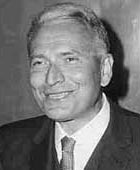Erwin Chargaff was awarded the Dr H.P. Heineken Prize for Biochemistry and Biophysics 1964 for his pivotal contribution to our knowledge of the chemical structure of nucleic acids, which, together with proteins, belong to the main compounds in the living cell.
Professor Chargaff’s discovery that the composition of deoxyribonucleic acid (DNA), the characteristic component of the cell nucleus, is species-specific immediately opened up the possibility that these compounds form an essential part of the hereditary process. It is obvious that if the desoxyribonucleic acid is the repository of the genetic information of the cell, this information – the so-called genetic code – must be spelled out by the sequence of bases in the polynucleotide chain. The second conclusion that Professor Chargaff drew in 1950 was that, although the desoxyribonucleic acids in different species have widely different compositions, there is a certain regularity. This led to analytical data that provided the evidence for base pairing in desoxyribonucleic acids. This concept of base pairing provided chemical evidence in favour of the celebrated Watson-Crick ‘spiral staircase’ model of nucleic acid, which was proposed in 1953. In 1951, Professor Chargaffwrote: ‘The most important question of the sequence in which, in a particular nucleic acid, the nucleotides follow each other has so far barely been approached. The elaboration of methods of sequence analysis is, perhaps, one of the most urgent problems in nucleic acid chemistry.’ Since then considerable progress has been made in this analysis of the genetic code.
Biography
Erwin Chargaff, an Austrian by birth (born August 11, 1905), received his training in Vienna, studying chemistry at the University of Vienna. Thereafter, he spent two years as Research Fellow at Yale University, three years at the University of Berlin, and two years at the Institut Pasteur in Paris in the laboratories of Dr Calmette. In 1935, he joined Columbia University. From 1970-1974 he was Chairman of the Department of Biochemistry, Columbia University. Since 1974 he has been Professor Emeritus of Biochemistry.
The principal fields of biochemistry in which he has been interested include nucleic acids and nucleoproteins, lipids and lipoproteins, the chemistry of pathogenic bacteria, blood coagulation, the metabolism of phosphorus, hydroxyamino acids, and inositol. He has published about 260 papers, was the principal editor of The Nucleic Acids, a treatise in three volumes, and is the author of Essays on Nucleic Acids. He has been for many years one of the editors of Biochimica et Biophysica Acta.
He has travelled extensively in Europe, Asia and South America as a lecturer and visiting professor, and was a member of the American Academy of Arts and Sciences, and of the Royal Physiographic Society in Lund, Sweden. In December 1963 the French Academy of Sciences awarded him the Charles Leopold Mayer Prize for his work on nucleic acids. He also was a holder of the Pasteur and Neuburg Medals.
In expressing his thanks after receiving the Dr H.P. Heineken Prize, Professor Chargaff, who contributed so substantially to the decoding of some of the mysteries of the living cell and of life itself, said: ‘The best thing one can say about a student of nature is: ‘He learned much, he taught more.’ I too have had many pupils. Whether I could teach them much only the future can tell. But I hope I taught them one thing, namely, that it is the first duty of a scientist to know when to say: ‘I do not know.’
Erwin Chargaff died at the age of 96 in 2002.
